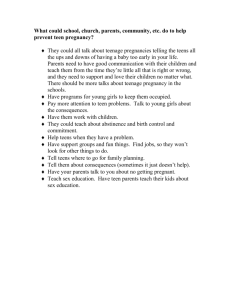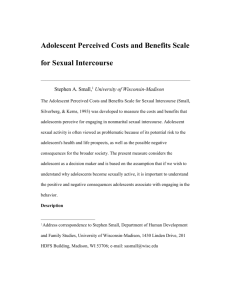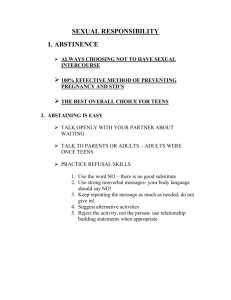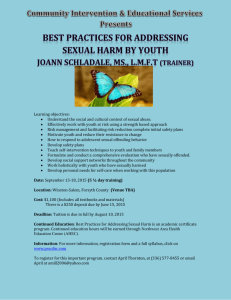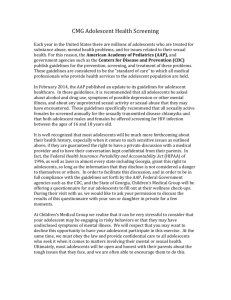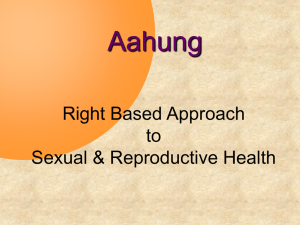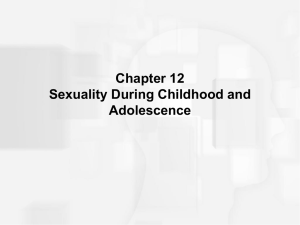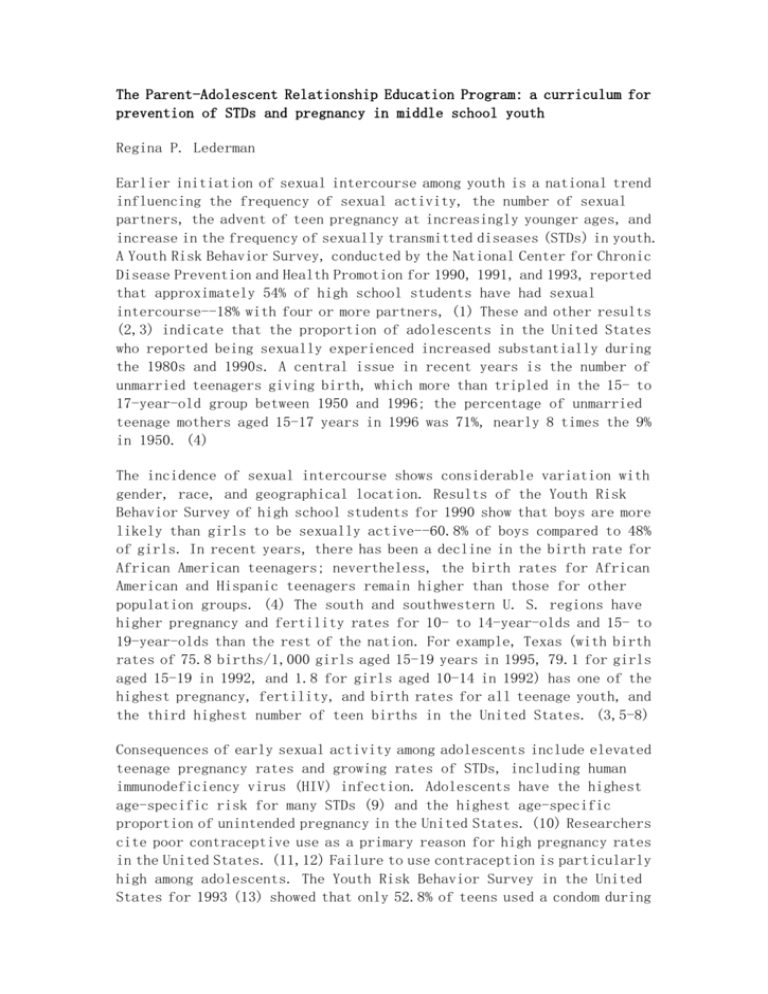
The Parent-Adolescent Relationship Education Program: a curriculum for
prevention of STDs and pregnancy in middle school youth
Regina P. Lederman
Earlier initiation of sexual intercourse among youth is a national trend
influencing the frequency of sexual activity, the number of sexual
partners, the advent of teen pregnancy at increasingly younger ages, and
increase in the frequency of sexually transmitted diseases (STDs) in youth.
A Youth Risk Behavior Survey, conducted by the National Center for Chronic
Disease Prevention and Health Promotion for 1990, 1991, and 1993, reported
that approximately 54% of high school students have had sexual
intercourse--18% with four or more partners, (1) These and other results
(2,3) indicate that the proportion of adolescents in the United States
who reported being sexually experienced increased substantially during
the 1980s and 1990s. A central issue in recent years is the number of
unmarried teenagers giving birth, which more than tripled in the 15- to
17-year-old group between 1950 and 1996; the percentage of unmarried
teenage mothers aged 15-17 years in 1996 was 71%, nearly 8 times the 9%
in 1950. (4)
The incidence of sexual intercourse shows considerable variation with
gender, race, and geographical location. Results of the Youth Risk
Behavior Survey of high school students for 1990 show that boys are more
likely than girls to be sexually active--60.8% of boys compared to 48%
of girls. In recent years, there has been a decline in the birth rate for
African American teenagers; nevertheless, the birth rates for African
American and Hispanic teenagers remain higher than those for other
population groups. (4) The south and southwestern U. S. regions have
higher pregnancy and fertility rates for 10- to 14-year-olds and 15- to
19-year-olds than the rest of the nation. For example, Texas (with birth
rates of 75.8 births/1,000 girls aged 15-19 years in 1995, 79.1 for girls
aged 15-19 in 1992, and 1.8 for girls aged 10-14 in 1992) has one of the
highest pregnancy, fertility, and birth rates for all teenage youth, and
the third highest number of teen births in the United States. (3,5-8)
Consequences of early sexual activity among adolescents include elevated
teenage pregnancy rates and growing rates of STDs, including human
immunodeficiency virus (HIV) infection. Adolescents have the highest
age-specific risk for many STDs (9) and the highest age-specific
proportion of unintended pregnancy in the United States. (10) Researchers
cite poor contraceptive use as a primary reason for high pregnancy rates
in the United States. (11,12) Failure to use contraception is particularly
high among adolescents. The Youth Risk Behavior Survey in the United
States for 1993 (13) showed that only 52.8% of teens used a condom during
their last intercourse. Approximately 4 in 10 girls become pregnant at
least once before age 20. (14) Between 1960 and 1991, the US fertility
rate for girls aged 10-14 years rose from 0.8 to 1.4; for the southeastern
United States, a rate as high as 5.7 was reported in 1992. (13) Many of
the risk indicators for teen pregnancy are also risk factors for repeat
pregnancy. (15) Younger teens also are more likely to have a shorter
interval between first and second births than older teens. (16) Failure
to use birth-control methods, such as condoms, places adolescents at
increased risk of exposure to STDs. The risk is still greater for
adolescents who are younger at first intercourse and acquire multiple
partners more quickly. (17) Teens are at high behavioral risk for
acquiring most STDs. Chlamydia and gonorrhea are the most common curable
STDs among teens. Researchers report it is common to see more than 5% of
young men and 5-10% of young women infected with chlamydia. (18) Among
women younger than age 25, studies have found that 28-46% are infected
with human papilloma virus. (19) Furthermore, herpes infection increased
among teens through the early 1990s. (19) Of the more than 350,000 16to 21-year-olds tested, more than 2:1,000 were HIV-infected, with rates
among young African American women exceeding 5:1,000. As reported in the
Journal of Acquired Immune Deficiency Syndrome and Human Retrovirology,
(20) African American women had the highest HIV infection rate of any group.
HIV prevention efforts have contributed to a significant slowing in the
spread of the HIV epidemic, yet many young men and women continue to be
infected with HIV. (21) Teens who contract STDs and do not seek treatment
face additional risks. Long-term sequelae associated with untreated
sexually transmitted infections include infertility, tubal pregnancy,
fetal and infant loss, chronic pelvic pain, and cervical cancer. (22)
Furthermore, infection with 1 STD increases the probability of
contracting and being diagnosed with another STD. (23) Both ulcerative
and nonulcerative STDs increase HIV infection risks as much as three- to
fivefold. (24)
FAMILY STRUCTURE, INVOLVEMENT, COMMUNICATION, AND VALUES
Family involvement, family structure, parental values, parental
monitoring, and parent--child communication are important factors
influencing critical life choices and are a crucial part of teen pregnancy
prevention. The closeness of family ties, parental preteen support, and
especially mother--daughter relationships is associated with teens not
having sex (25,26-28) or delaying the onset of sexual intercourse,
(29,30-35) a lower frequency of intercourse, (36,37))more consistent use
of contraception by sexually active teens, (37) and a reduced risk of teen
pregnancy. (38) Conversely, low parental support and involvement has been
related to sexually permissive attitudes of teens and an association with
sexually active friends. (39) Parental monitoring is related to less
frequent sexual intercourse, (36) lower sexual risk-taking, (40) and
delayed first intercourse. (29,35) Discussion of HIV and AIDS between
parents and children was also related to a decreased likelihood of teens
having multiple partners and unprotected intercourse. (41) Notably, Picks
and Palos (42) found that frequent mother--laughter discussions about sex
was associated with a lower probability of daughters having sex and
getting pregnant and a higher likelihood of using contraception.
Furthermore, parents who participate in programs to improve communication
do increase communication with their adolescents and report more comfort
in doing so. (43)
CHARACTERISTICS OF EFFECTIVE AND INEFFECTIVE PREVENTION PROGRAMS
Reviews of abstinence-only programs have not found consistent and
significant effects on delaying the initiation of intercourse. (44)
Similarly, sex education programs that did not specifically target
resistance skills to reduce risk behavior also did not demonstrate
significant differences in sexual activities or the use of contraception.
(45,46) Effective programs should provide basic, accurate information
about the risks of participating in, and the methods of avoiding,
unprotected intercourse, and should promote abstinence and inform teens
about contraception. Given that fostering teen-parent communication has
been significantly associated with a teen's decision to delay intercourse
(30) and to use contraception, (47) a program that integrates abstinence
and contraception through parent-teen communication should expect to have
greater combined results.
Programs effective in reducing unsafe sexual practices had several
important characteristics. (43,48,49) They targeted specific goals that
focused on reducing one or more sexual behaviors that led to unintended
pregnancy or STD infection, such as delaying the initiation of intercourse
or using adequate protection. Successful programs also focus on
recognizing social influences, changing group and individual norms, and
building social skills through role playing and interviewing practice.
They provided a process for implementing actions, not just new knowledge.
Useful programs also included behavior goals, teaching methods, and
materials that were tailored to the age, gender, sexual experience, and
culture of the student population. For example, delaying intercourse was
emphasized with a middle school population, whereas concepts of
abstinence in an older adolescent group were deemed less appropriate.
Culturally sensitive programs had speakers or teachers from the same race,
culture, and socioeconomic background that delivered culturally relevant
messages (50) and included culturally relevant concepts in class content.
(51)
Effective programs also continually reinforced prevention-oriented
content and behaviors. They provided basic, accurate information about
the risks and methods of avoiding unprotected intercourse. They included
activities addressing social pressures on sexual behaviors and providing
modeling and practice in communication, negotiation, and refusal skills.
Effective programs selected teachers or peers who believed in the program
they were implementing and then provided training for them.
Many of the characteristics of successful programs are seen in the
Elements of Promising Programs, (52) which states that programs should
have a clearly defined target population and be culturally relevant, using
input from the community to achieve this goal. They should have a
foundation in cognitive theory, provide specific skills training, and use
active rather than passive participant learning.
The timing of implementing preventive sex education programs may be
pertinent. For example, it may be important to consider seasonal variation
in teen conceptions. The peak months of conception for those aged younger
than 18 years are May, June, and December, which coincide with breaks from
school and other organized teen activities. (53) Potential benefits could
accrue by increasing prevention efforts before high-risk periods.
Few programs are designed specifically for middle or elementary school
students; the vast majority of programs address high school students. In
1 study, (54) low-income African American students in eighth grade
participated in a program entitled, "Postponing Sexual Involvement,"
based on social learning theory, to help youth understand social and peer
pressure and develop resistance skills. The course, taught by eleventh
and twelfth grade students, included a human sexuality component covering
decision-making and contraceptive use. This program showed significant
results in delaying the initiation of intercourse in students tested in
the eighth and ninth grade, but not in twelfth grade. The frequency of
intercourse was reduced in ninth grade students who were sexually
inexperienced at pretest, but not among those who were sexually
experienced. Likewise, contraceptive use was increased only in ninth
grade students who were sexually inexperienced at pretest. The results
indicated greater program effectiveness for younger, less experienced
adolescents. This study by Howard and McCabe (54) and other studies (46)
demonstrate factors important for inclusion in curriculum design. Once
patterns of sexual initiation are established, they are difficult to
change. It is very important to reach youth before sex is initiated to
introduce concepts of safe sex and a rationale for delaying sexual
initiation to prevent HIV/AIDS and pregnancy.
Few studies have incorporated a parent--child component and tested the
short and long-term effectiveness of a joint parent--child component for
the prevention of teen pregnancy and STDs, although this approach is now
recommended by national review panels and other research and interest
groups. (55,56) Interventions in the past often have been implemented with
parents or youth separately. Researchers suggest that parents need to be
involved to a greater extent in the sex education of adolescents, and that
there needs to be some emphasis on parental efficacy as well. Hogan and
Kitagawa (1985) showed that parental control of dating (supervision and
control over hours, locations, and partners) was a strong inhibitor of
adolescent sexual activity and pregnancy. Important factors in delaying
teen sexual behavior include consistency between teen and parent values
and the closeness of family ties. (30,32,34,57) Parents also need
effective communication skills to talk with and listen to their teens.
In particular, they need skills regarding setting limits and dating rules.
(58) As noted, the fostering of teen-parent communication, particularly
between mother and daughter, has been significantly associated with a
teen's decision to delay intercourse (30) or to use contraception. (47)
Involving parents reduces their opposition to sex education and enhances
their support. Brown, Downs, Peterson, and Simpson (59) taught sexuality
courses using community sponsorship and support and have consistently and
effectively recruited and maintained parental involvement from course
beginning to end. Wilson, Kastrinakis, D'Angelo, and Getson (60) reported
that communication with parents and parental suggestion to use condoms
has been effective in increasing condom use in Black boys aged 11-19 years
whose average age of first intercourse was 12.4 years. In a study using
focus groups with high-risk adolescents, teens from several different
ethnic groups all cited that their life priorities were "being loved" and
"having a family." (61) The youth stated they wanted to talk with someone
they could trust and who knew what they were going through, suggesting
that parental involvement, particularly with very young teens, could have
salutary effects on adolescent choices, including those about sexual
behavior. Research suggests a more pivotal role for parents in the
prevention of teen pregnancy than has yet occurred. (62)
CONSTRUCTION OF A MIDDLE SCHOOL PARE PROGRAM FOR PARENTS AND TEENS
The Parent--Adolescent Relationship Education (PARE) curriculum was
developed to target youth aged 12-14 years, and encourage the involvement
of parents in the education of their children. The curriculum is based
on findings that teens, particularly early teens, need parental support
and communication to develop healthy psychosocial and sexual behaviors
and to counteract powerful pressures for unsafe behaviors. Parental
behaviors, particularly attitudes and statements of approval and
disapproval of preteen behaviors, determine to a great extent the
attitudes held by preteens entering adolescence. It is expected that
parental influence is greater in the preteen school years than in the high
school years, when the peer group assumes more influence.
Literature reports further indicate that adequate family communication
may delay the onset of adolescent sexual activity, cigarette smoking, and
alcohol and marijuana use. (26,63-65) Although there are many
school-based sex education and STD prevention curricula, those that offer
both knowledge and skill training to adolescents and their families are
extremely rare. (65-67)
The PARE curriculum was developed after a review of the literature and
several course manuals on sexuality and sex education programs. We
selected course materials from experimental research courses that
obtained significant results in delaying sexual initiation and increasing
safe-sex practices. The curriculum manuals that we consulted most
frequently were: (1) Postponing Sexual Involvement: An Educational Series
for Young Teens by Howard and Mitchell, (68) (2) Reducing the Risk:
Building Skills to Prevent Pregnancy, STD, and HIV, third edition, by
Barth, (69) and (3) Parent-Child Sex Education: A Training Module by Brown,
Downs, Peterson, and Simpson. (59) These course materials are based on
social learning theory. The first two have emanated from rigorous research
projects that have obtained significant results in changing patterns of
student sexual decision-making and behavior outcomes. The third
identifies consistently successful parental recruitment protocols using
established community institutions.
DESIGN
Participants
The project targets 12- to 14-year-old school youth in grades 6, 7, and
8 and their parents for participation in a preteen pregnancy and STD
prevention project. Middle school youth were selected because they have
almost reached sexual maturity, they are at an age when many initiate
sexual activities, and because sexual initiation is occurring at
increasingly younger ages, especially among urban minority youth.
School teachers and administrators reported that sixth grade students
attempt to acclimate rapidly into the middle school culture and try to
fit in and be accepted. One way of doing this is by having sex. The onset
of sexual activity is between 25% and 65% for students aged 12-14 years;
higher rates are more likely to occur in racially integrated schools. (70)
Furthermore, two educators participating in our research project in
construction of the curriculum and who had previously taught sexuality
classes observed, as have others, (33) that 12- and 13-year-old youth
commonly engage in sexual or presexual behaviors that are antecedents to
the initiation of sexual intercourse.
The participants in the project are 150 parent--child dyads recruited from
5 middle schools in 2 different school districts in southeast Texas.
Parents and students in each school participate in one of 2 randomly
assigned conditions: (1) an experimental treatment group (n = 75), or (2)
an attention-control group (n = 75). The treatment group receives the
social learning teaching approach described below, whereas the
attention-control group receives similar factual content taught in a
traditional didactic approach and without social learning exercises. Both
groups meet the same number of sessions and hours. The experimental and
control groups meet on different days to control for validity
contamination.
Before initiating the program protocol, we sought active consent from all
participating parents and students by sending letters to parents via the
students and through the mail informing them of the course and providing
details regarding their participation. The school principals endorsed the
program and signed the letters, which were written in both English and
Spanish. We held classes after regular school hours in the respective
schools.
We used incentives in each class to encourage parental and student
attendance at classes, including meals and raffles of random awards and
prizes in each class session. The last class (fourth session) in each
school included a prize of higher than usual value; we informed parents
of this at the start of classes. We used motivational methods, including
reminder letters, telephone calls, and incentives to minimize attrition.
The Experimental Curriculum
The PARE curriculum includes social learning and cognitive-behavioral
theoretical approaches in the education of parents and teens. The social
learning model (71) includes teacher and peer modeling of desirable
behaviors and the practice of these behaviors through role playing. The
model also includes elements of self-efficacy, (72) an individual's
belief that if certain methods are employed, they will be successful (ie,
preventing pregnancy or the contraction of STDs), that benefits can accrue
to the individual, and that the individual is capable of accomplishing
the necessary behaviors to attain the goal. Cognitive behavioral models
(73) further posit that specific cognitive and behavioral skills are
needed to resist pressures for sexual activity. The PARE curriculum
includes activities to personalize information about sexuality and
reproduction, and provides training in problem-solving, decision-making,
and assertive communication skills. Practice opportunities are provided
for applying these skills in difficult situations. Class sessions for
parents and youth include content on adolescent development, reproductive
changes during puberty, peer and media pressures, the consequences and
responsibilities of sexual behavior, resistance training, role-playing,
communication with peers and parents, practice exercises, and behavioral
reinforcement, all important components of behavior change. In addition,
abstinence, and methods to prevent pregnancy and STDs also were discussed.
The course targets youth at a period when the greatest increase in
initiation of sexual behavior occurs and focuses on strengthening family
communication overall, particularly on teen sexuality.
The PARE program is a 4-week course that meets once each week. During the
first half of each class session, parents and youth attend a 1 l/2-hour
class separately; during the last half of each session, parents and youth
attend a 1 l/2 hour class together. Each session includes a brief review
of the prior session and builds upon that content to enhance communication.
The second half of each session consists of a combined parent--adolescent
education unit. During these classes, parents and teens have the
opportunity to process together what they have learned independently and
to practice their new skills. Role-playing opportunities are included in
every joint parent--child experimental class session.
In Session I of both the parent and adolescent education units, we taught
parents and children separately in classes that focused on puberty and
barriers to parent--child communication. We discussed the physical,
emotional, and relationship changes of puberty. Adolescents learned what
to look for in a good relationship with parents. We also taught them the
barriers to effective communication with parents and how to circumvent
them. In a similar fashion, we taught parents how to avoid obstacles to
communication with children. Parents learned about what to expect from
young people during adolescence, how to be a parent during this time, and
about different parenting styles. Also in the first session, adolescents
and parents learned how to identify and avoid risky situations, such as
those involving drugs and sex. Adolescents learned that an important
component of good communication is how to say "no" to friends and how to
effectively deal with peer pressure.
After a review of Session I, the Session II class concentrated on effective
communication. Parents and adolescents independently became familiar
with how to open the lines of communication, the tools needed for good
communication, and what to expect from each other. They also familiarized
themselves with the responsibilities of sexual behavior, such as
contraceptive use and honest communication with their partner, as well
as with the consequences of sexual behavior, such as unintended pregnancy
and contracting STDs, such as HIV.
Session III provided students and parents with an overview of risky sexual
behaviors and the situational or environmental conditions that predispose
teens to risky behavior. We presented students with 2 risky scenarios of
unsupervised coeds: 1 at home after school and another at an unsupervised
party where alcohol and condoms were available. We asked students to
identify the risky conditions and behaviors, as well as the possible
outcomes. We then asked them to consider strategies to better manage and
avoid risky situations. Students also learned advance planning for the
prevention of risky circumstances.
In Session IV, educators reinforced the ground rules for effective
communication between parents and adolescents, and reviewed the content
and skills of the parent and adolescent education units of Session III
that are prerequisite to the learning and role-playing activities, and
discussions of Session IV. We taught parents and students to identify
situations that caused them stress and ways to deal with them.
Participants also learned how to overcome barriers and reach life goals.
In the joint parent-teen class in the second half of Session IV, educators
assisted the parents and adolescents in sharing the emotional and
cognitive aspects of their experience and in defining future goals.
Following the initial PARE program of 4 weekly sessions, 3 maintenance
or booster sessions were arranged for both study groups--1 each semester
for three consecutive semesters. Each booster session was again divided
into 2 classes with the parents and adolescents apart in the first half
of the session and together in the second half. The purpose of the booster
sessions, particularly Session I, was to bring the parents and adolescents
together and explore their successful and unsuccessful experiences with
their peer and familial relationships over the previous months. Booster
sessions were designed to re-examine previously learned material and to
provide new information. During the booster sessions, we provided the
participants with a supportive environment to practice their skills. The
latter 2 booster sessions focused on specific issues. Booster Session II
focused on personal values, beliefs, attitudes, and communication,
whereas Booster Session III focused on dating, including what it means
to date, what can happen on a date, and how parents can help youth prepare
for dating.
Four facilitators or teachers in the first year taught each of the initial
4 sessions: 1 teacher for the girls' group, 1 for the boys' group, 1 for
an English-speaking parent group, and 1 bilingual teacher for a
Spanish-speaking parent group. For the booster classes, we combined boys'
and girls' classes, which were led by 1 teacher. We used the same number
of facilitators and classes for both the experimental and control groups.
Almost all facilitators were prepared at the master's degree level or
beyond and were practicing licensed marriage and family therapists,
licensed professional counselors, psychiatric residents or fellows in
adolescent medicine, or health educators. Several of the facilitators
held positions as HIV/AIDS and STD counselors. Largely, we were able to
match teachers and students by predominant race or ethnic group.
Approximately 4 to 8 students or parents participated in each of the
sessions in the different schools; classes doubled in size for the
combined parent-teen classes.
Measurement Instruments
We developed all of the instruments used in the project from existing
instruments used in research projects by other investigators. The design
included the administration of 2 survey pretests, 4 to 6 months apart,
before initiation of the program. The purpose of the inclusion of 2 survey
pretests was to adjust for threats to validity because of selection biases.
(74) With 2 periods of survey assessment before the intervention, we could
also test for baseline levels of attitudes and note the direction of change
in attitudes and behaviors.
Survey. The middle school survey is adapted principally from the National
Youth Survey developed by ETR Associates. (75) The youth survey was
designed to measure beliefs and practices about unsafe sexual behavior,
STDs, and AIDS in sixth-, seventh-, and eighth-grade youths. For our
survey of middle school youth, we added items to explore the children's
perceptions of how their parents regarded them, specifically in areas of
perceived opinions and/or expectations regarding school performance,
ability to succeed, and knowledge of the child's whereabouts, as well as
parental disapproval of risky behaviors, including substance abuse,
sexual intercourse, and pregnancy. We also included items inquiring about
the amount, ease, and enjoyment of parent--teen communication in general,
and specifically on the extent of discussions about abstinence, birth
control and pregnancy, and the prevention of STDs and pregnancy. Finally,
we included items on the extent of parental involvement and closeness in
the children's lives. The survey can be completed in approximately 30-45
minutes. After obtaining parent and student signed consent forms, we
administered the survey to all consenting youth in the participating
middle schools and participants in the PARE program.
Questionnaires. We administered student and parent questionnaires before
the beginning of the first class session, at the end of the last (fourth)
class session of the intervention program, and at the beginning and end
of each of the three booster sessions. The items in the questionnaires
were selected from existing questionnaires used in health risk and
prevention research. We modified some of the items to make them
appropriate for middle school youth. The categories of items selected were
those that would be covered in the sessions and that have been found in
the literature to be correlates of early sexual behavior and pregnancy.
Item content of the student questionnaires focused on the extent and
comfort of student--parent discussions about AIDS, condoms and
contraception, alcohol and substance use, sex and safe sex, and STD and
pregnancy prevention, and the extent of discussion on these topics with
friends. We also included items on the perceived importance of parents'
feelings in the student's choice of friends, alcohol and drug use, and
having sex, and on whether there were parental rules about going on dates
or to parties, substance use, staying out late, choice of friends, places
to visit after school, sex, and contraception. We also assessed students'
knowledge about AIDS, transmittal of STDs, and circumstances under which
pregnancy can occur, along with opinions about condom or foam use and the
student's chances of contracting AIDS or getting pregnant, and specific
circumstances that presented risk. We included items on students'
decision-making methods and resistance and refusal skills in risky
circumstances. In addition, we included items addressing students'
perception of parental involvement in homework, the teens' school
activities, and parental programs at school to determine the relationship
of these factors with sex initiation, contraceptive use, the use of
refusal and resistance skills, other sex behaviors, pregnancy prevention,
and risky behaviors.
The parent questionnaire contained items that were parallel in content
to the topics and items on the student questionnaire. For example, parent
questionnaire items assessed the extent and comfort parents had in
discussions; parental opinions of their child's potential behaviors;
opinions about the appropriateness of different STD and pregnancy
prevention methods; views on male and female responsibility for safe sex;
knowledge about AIDS/STDs and risks of pregnancy; opinions about condom
use; and the extent of parental upset if their child used drugs or alcohol,
had sex, or got pregnant.
Orientation of PARE Program Facilitators/Teachers
The first author (RPL) interviewed and hired all of the facilitators
(teachers) for the PARE program. All 31 facilitators attended orientation
and training classes. An experienced educator who had previously trained
facilitators on other NIH grant projects conducted all orientation
sessions. Two of the facilitators had a baccalaureate degree--1 was a
grade school teacher, and the other had a degree in psychology and worked
for the Red Cross. The remaining 29 facilitators each held a master's
degree, were doctoral students, or held a doctoral degree in a social
science discipline. Three facilitators were psychiatric physicians,
either residents or fellows. Orientation and training sessions provided
a review of class content, opportunities to address and discuss sexual
issues and questions that could arise in classes, and directions and
discussion about teaching approaches for the experimental and control
groups. In the vast majority of teaching assignments, the same
facilitators taught each of the initial series of intervention classes.
Facilitators teaching in the experimental program group did not teach in
the attention control group classes. For the maintenance and booster class
sessions offered at 6-month intervals, it was still possible to assign
facilitators to the experimental and attention control groups consistent
with their original assignment in most instances, but less often to the
same groups of parent--student dyads. Detailed, written class guidelines
on content to be covered and specific teaching approaches for the
experimental group classes and the separate attention control group
classes were also given to each of the facilitators and reviewed with them.
Periodically, feedback was sought from facilitators on the adequacy of
the guidelines provided. Suggestions for modifications were incorporated
into the subsequent written materials. Overall, facilitators found the
written materials satisfactory and easy to follow and implement.
COMMENT
The research project on teen pregnancy and STD/HIV prevention and the PARE
curriculum developed by project personnel is novel in several respects.
The project targeted middle school youth (vs high school youth), and
parents and students together in both separate and dyadic learning
sessions. Comprehensive content is provided on risks and protective
measures and on both abstinence and safe sex. The program has a distinctive
focus on family interaction and parent--teen communication skills, as is
emphasized by the National Campaign to Prevent Teen Pregnancy. (71)
Afterschool and early evening classes are offered for both parents and
youth. In addition, maintenance or booster sessions at 6-month intervals
are provided after the initial intervention class series to review content
and skills, reinforce prevention messages to reduce and manage risk, and
foster continued parent--teen communication and interaction. Of the 5
Centers for Disease Control approved programs for teen pregnancy and
HIV/AIDS prevention, only 1 is for middle schools, and none use a joint
parent--teen educational format.
ACKNOWLEDGMENT
This study was funded by National Institute for Nursing Research Grant
R01NR004678.
REFERENCES
(1.) Centers for Disease Control. Trends in sexual risk behaviors among
high school students--United States, 1990, 1991, and 1993. MMWR.
1995;44:124-131.
(2.) Centers for Disease Control. Premarital sexual experience among
adolescent women--United States, 1970-1988. MMWR. 1991;39;929-932.
(3.) Ventura SJ, Taffel SM, Mosher WD, Henshaw S. Trends in Pregnancies
and Pregnancy Rates, United States, 1980-1988. Hyattsville, MD: US
Department of Health and Human Services; 1992.
(4.) Ventura SJ, Curtin SC, Mathews TJ. Teenage Births in the United States:
National and State Trends, 1990-1996. Hyattsville, MD: National Center
for Health Statistics; 1998.
(5.) National Center for Health Statistics. Vital Statistics of the United
States, 1988--Vol.1: Natality. Washington, DC: US Government Printing
Office; 1990.
(6.) National Center for Health Statistics. Advance Report on Final
Natality Statistics. Washington, DC: US Government Printing Office; 1991.
(7.) Public Health Service. MVSR. 1993;42(suppl 3).
(8.) Centers for Disease Control. State-specific Pregnancy and Birth
Rates Among Teenagers--United States, 1991-1992. MMWR. 1995;44 677-584.
(9.) Centers for Disease Control. Sexually Transmitted Disease
Surveillance, 1996. Atlanta, GA: Centers for Disease Control; 1997.
(10.) Institute of Medicine, Committee on Unintended Pregnancy. The Best
Intentions: Unintended Pregnancy and the Well-Being of Children and
Families. Washington, DC: Institute of Medicine; 1995.
(11.) Gilcrest V. Preventive health care for the adolescent. Am Fam
Physician. 1991;43:869-879.
(12.) Holden GW, Nelson PB, Velasquez J, Ritchie KL. Cognitive,
psychosocial, and reported sexual behavior differences between pregnant
and nonpregnant adolescents. Adolescence. 1993;28;557-572.
(13.) Centers for Disease Control. Adolescent Health: State of the
Nation--Pregnancy, Sexually Transmitted Diseases, and Related Risk
Behaviors Among U.S. Adolescents. Atlanta, GA: US Department of Health
and Human Services; 1995. Publication No. CDC 099-4630.
(14.) Henshaw SK, Van Vort J. Teenage abortion, birth, and pregnancy
statistics: an update. Fam Plann Perspect. 1998;21:85-88.
(15.) Dryfoos J. Adolescents at Risk: Prevalence and Prevention. New York:
Oxford University Press; 1995.
(16.) DiClemente RJ, Fisher RD. Social influence factors associated with
consistent condom use among adolescents in an HIV epicenter:
communication and referent group norms. J Adolesc Health.
1992;12:385-390.
(17.) Kost K, Forrest JD. American women's sexual behavior and exposure
to risk of sexually transmitted diseases. Fam Plann Perspec.
1992;24:244-254.
(18.) Mertz KJ, McQuillan GM, Levine WC, et al. A pilot study of the
prevalence of chlamydial infection in a national household survey. Sex
Transm Dis. 1998;5:225-228.
(19.) Centers for Disease Control. Tracking the hidden epidemic trends
in STDs in the United States 2000. Available at:
http://www.cdc.gov/nchstp/dstd/Stats_Trends/STD_Trends.pdf. Accessed
October 6, 2001.
(20.) Valleroy L, MacKellar DA, Karon JM, Janssen RS, Hayman CR. HIV
infection in disadvantaged out-of-school youth. J Acquir Immune Defic
Syndr Hum Retrovirol. 1998;19:67-73.
(21.) Centers for Disease Control. National Data on HIV Prevalence Among
Disadvantaged Youth in the 1990s. Available at:
http://www.cdc.gov/hiv/pubs/facts/jobcorps.htm. Accessed October 8,
2001.
(22.) Donovan P. Testing Positive: Sexually Transmitted Diseases and the
Public Response. New York: Alan Guttmacher Institute;1993.
(23.) Aral SO, Holmes KK. The epidemiology of sexual behavior and sexually
transmitted diseases. In Holmes KK, ed. Sexually Transmitted Diseases.
2nd ed. New York: McGraw-Hill;1990.
(24.) Wasserheit JN. Epidemiological synergy: interrelationships between
HIV infection and other STDs. Sex Transm Dis. 1992; 19:61-77.
(25.) Fox GL, Inazu JK. Patterns and outcomes of mother-daughter
communication about sexuality. J Soc Issues. 1980;36:7-29.
(26.) Inazu JK, Fox GL. Maternal influence on the sexual behavior of
teen-age daughters: Direct and indirect sources. J Fam Issues.
1980;1:81-102.
(27.) Whitbeck L, Hoyt D, Miller M, Kao M. Parental support, depressed
affect, and sexual experiences among adolescents. Youth Soc.
1992;24:166-177.
(28.) Jensen LC, DeGaston JF, Weed SE. Societal and parental influences
on adolescent sexual behavior. Psychol Rep. 1994;75:928-930.
(29.) Danziger SK. Family life and teenage pregnancy in inner-city:
Experiences of African American youth. Child Youth Serv Rev.
1995;17:128-202
(30.) Fox GL. The family's role in adolescent sexual behavior. In Ooms,
T. ed. Teenage Pregnancy in a Family Context. Philadelphia, PA: Temple
University Press; 1981.
(31.) Jessor R, Costa F, Jessor L, Donavan J. Time of first intercourse:
a prospective study. J Pers Soc Psych. 1983;44:608-626.
(32.) Jessor SL, Jessor R. Transition from virginity to nonvirginity among
youth: a social-psychological study over time. Dev Psych. 1975;11:473.
(33.) Miller BC, Norton MC, Curtis T, Hill EJ, Schvaneveldt P, Young MH.
The timing of sexual intercourse among adolescents: family, peer, and
other antecedents. Youth Soc. 1997;29:54-83.
(34.) Shah FK, Zelnik, M. Parent and peer influence on sexual behavior,
contraceptive use and pregnancy experience of young women. J Marriage Fam.
1981;43:339-348.
(35.) Upchurch DM, Levy-Storms L, Sucoff CA, et al. Gender and ethnic
differences in the timing of first sexual intercourse. Fam Plann Perspect.
1998;30:121-127.
(36.) Benda BB, Di Basio FA, Kashner TM. Adolescent sexual behavior: a
path analysis. Journal of Social Service Research. 1994;19:49-69.
(37.) Jaccard J, Dittus PJ, Gordon VV. Maternal correlates of adolescent
sexual and contraceptive behavior. Fam Plann Perspect.
1996;28,159-165,185.
(38.) Resnick MD, Bearman PS, Blum R, et al. Protecting adolescents from
harm: findings from the National Longitudinal Study on Adolescent Health.
JAMA. 1997;278:823-832.
(39.) Whitbeck L, Conger R, Kao M. The influence of parental support,
depressed affect, and peers on the sexual behaviors of adolescent girls.
J Fam Issues. 1993;14:261-278.
(40.) Luster T, Small SA. Factors associated with risk-taking behaviors
among adolescents. J Marriage Fam. 1994;56:622-632.
(41.) Holtzman D, Robinson R. Parent and peer communication effects on
AIDS-related behavior among U.S. high school students. Fam Plann Perspect.
1995;27:235-240,268.
(42.) Picks S, Palos PA. Impact of the family on the sex lives of
adolescents. Adolescence. 1995;30:667-675.
(43.) Kirby D. Sexuality and sex education at home and at school. Adolesc
Med. 1999;10:195-209.
(44.) Kirby D. A Review of Educational Programs Designed to Reduce Sexual
Risk-taking Behaviors Among School-aged Youth in the United States.
SpringfieLd, VA: National Technical Information
Service;1995.PB96108519.
(45.) Eisen M, Zellman GL, McAlister AL. Evaluating the impact of a
theory-based sexuality and contraceptive education program. Fam Plann
Perspect. 1990;22:261-271.
(46.) Kirby D, Barth RP, Leland N, Fetro JV. Reducing the risk: impact
of a new curriculum on sexual risk-taking. Fam Plann Perspect.
1991;23:253-263.
(47.) Jorgensen SR, Sonstegard JS. Predicting adolescent sexual and
contraceptive behavior: an application and test of the Fishbein model.
J Marriage Fam. 1984;46:43-55.
(48.) Leland NL, Barth RP. Gender differences in knowledge, intentions,
and behaviors concerning pregnancy and sexually transmitted disease
prevention among adolescents. J Adolesc Health. 1992;13:589-599.
(49.) Santelli JS, DiClemente RJ, Miller KS, Kirby D. Sexually transmitted
diseases, unintended pregnancy, and adolescent health promotion. Adolesc
Med. 1999;10:87-108.
(50.) Jemmott JB, Jones JM. Social psychology and AIDS among ethnic
minority individuals: risk behaviors and strategies for changing them.
In Pryor J, Reeder G, eds. The Social Psychology of HIV Infection.
Hillsdale, NJ: Lawrence Erlbaum Associates; 1993:183-224.
(51.) Asante MK. Afrocentric curriculum. Educ Leadership, 1991;49:28-31.
(52.) National HIV Prevention Conference. Elements of Promising Programs.
Atlanta, GA: National HIV Prevention Conference; 1999.
(53.) Petersen DJ, Alexander GR. Seasonal variation in adolescent
conceptions, induced abortions, and late initiation of prenatal care.
Public Health Rep. 1992;107:701-706.
(54.) Howard M, McCabe JB. Helping teenagers postpone sexual involvement.
Fam Plann Perspect. 1990;22:21-26.
(55.) Carnegie Council on Adolescent Development; 1995
(56.) National Campaign to Prevent Teen Pregnancy. Whatever Happened to
Childhood? The Problem of Teen Pregnancy in the United States. Washington,
DC: National Campaign to Prevent Teen Pregnancy; 1997.
(57.) Hogan DE Kitagawa EM. The impact of social status, family structure,
and neighborhood on the fertility of black adolescents. Am J Soc.
1985;90:825-855.
(58.) Santelli JS, Beilenson P. Risk factors for adolescent sexual
behavior, fertility, and sexually transmitted diseases. J Sch Health.
1992;62:271-279.
(59.) Brown JG, Downs MM, Peterson L, Simpson CA. Parent-child Sex
Education: A Training Module. St. Joseph, MO: Parent-Child Experience,
Inc;1989.
(60.) Wilson MD, Kastrinakis M, D'Angelo LJ, Getson, P. Attitudes,
knowledge, and behavior regarding condom use in urban black adolescent
males. Adolescence, 29:13-26.
(61.) Advisory Panel on Health Promotion Strategies for High-Risk Youth.
Designing health promotion approaches to high-risk adolescents through
formative research with youth and parents. Public Health Rep.
1993;108(supp 1):68-77.
(62.) Miller BC. Families Matter: A Research Synthesis of Family
Influences on Adolescent Pregnancy. Washington, DC: National Campaign to
Prevent Teen Pregnancy; 1998.
(63.) McCubbin H, Needle R, Wilson M. Adolescent health risk behaviors:
family stress and adolescent coping as critical factors. Fam Rel.
1985;34:51-62.
(64.) Jaccard J, Dittus PJ. Parent-teen Communication: Toward the
Prevention of Unintended Pregnancies. New York: Springer-Verlag; 1991.
(65.) Winnet RA, Anderson ES, Moore JF. Efficacy of a home-based human
immunodeficiency virus prevention video program for teens and parents.
Health Educ Q. 1993;20:555-567.
(66.) Taylor J. Teaching AIDS Project. Santa Cruz: ETR Associates; 1991.
(67.) Fisher J, Fisher W. Changing AIDS risk behavior. Psych Bull 111.
1992:455-474.
(68.) Howard M Mitchell ME. Postponing Sexual Involvement: An Educational
Series for Young Teens. Atlanta, GA: Emory/Grady Teen Services Program,
Grady Memorial Hospital; 1990.
(69.) Barth RP. Reducing the Risk: Building Skills to Prevent Pregnancy,
STD, and HIV. 3rd ed. Scotts Valley, CA: ETR Associates; 1996.
(70.) Sagrestano LM, Paikkoff R. Preventing high-risk sexual behavior,
sexually transmitted diseases, and pregnancy among adolescents. In
Weissberg RP, ed. Health Children: Enhancing Children's Wellness. Newbury
Park, CA: Sage Publications; 1997.
(71.) Bandura A. Social Foundations of Thought and Action. Englewood
Cliffs, NJ: Prentice Hall;1986.
(72.) Bandura A. Perceived self-efficacy in the exercise of control over
AIDS infection. Eval Program Plann. 1990;13:9-17.
(73.) Bandura A. Social cognitive theory of self-regulation.
Organizational Behav Hum Decis Processes. 1991;50:248-287.
(74.) Cook TD, Campbell DT. Quasi-Experimentation: Design and Analysis
Issues for Field Settings. Boston, MA: Houghton Mifflin Co.; 1979.
(75.) ETR Associates. Middle school questionnaire (Unpublished). Scotts
Valley, CA: ETR Associates; 1993.
Dr Lederman is a professor at the School of Nursing and in the Deptartment
of Community Health and Preventive Medicine, Division of Sociomedical
Sciences, at the University of Texas at Galveston. Dr Mian is at
Brackenridge Hospital in Austin, Texas.
COPYRIGHT 2003 Heldref Publications
COPYRIGHT 2004 Gale Group

